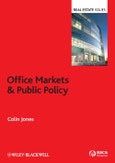This is the first book that looks at how offices and office markets in cities have changed over the last 30 years. It analyses the long-term trends and processes within office markets, and the interaction with the spatial economy and the planning of cities. It draws on examples around the world, and looking forward at the future consequences of information communication technologies and the sustainability agenda, it sets out the challenges that now face investors.
The traditional business centres of cities are losing their dominance to the brash new centres of the 1980s and 1990s, as the concept of the central business district becomes more diffuse. Edge cities, business space and office parks have entered the vocabulary as offices have also decentralised. The nature and pace of changes to office markets set within evolving spatial structures of cities has had implications for tenants and led to a demand for shorter leases. The consequence is a rethink of the traditional perception of property investment as a secure long term investment, and this is reflected in reduced investment holding periods by financial institutions.
Office Markets & Public Policy analyses these processes and policy issues from an international perspective and covers:
- A descriptive and theoretical base encompassing an historical context, a review of the fundamentals of the demand for and supply of the office market and offices as an investment. Embedded within this section is a perspective on underlying forces particularly the influence of technological change.
- A synthesis of our understanding of the spatial structure and dynamics of local office markets at the city level.
- An assessment of the goals and influence of planning policies, and the evaluation of policies designed toward the long term sustainability of cities as services centres.
This goes beyond standard real estate and urban economics books by assessing the changing shape of urban office markets within a spatial theoretical and policy context. It will be a useful advanced text for honours and postgraduate students of land economy; land management; property and real estate; urban planning; and urban studies. It will also be of interest to researchers, property professionals, policy-makers and planning practitioners.
Table of Contents
Acknowledgements ix
Preface xi
1 Introduction 1
History of offices 2
City office markets 6
Overview of office market trends 19
Book structure 20
2 Market Fundamentals 25
Growth of services 26
New technology, new work and new offices 28
New specialist office forms 31
The office stock 31
Constraining influences on the office property market 33
Office market cycles 37
Repeating the ‘mistakes’ 42
Conclusions 44
3 Submarkets and the Changing Nature of the Traditional
Central Business District 47
Economics of cities and office location 48
The Central Business District and intra-urban rent structures 50
Office submarkets 55
Identifying submarkets 59
Changing submarkets and a polycentric office market 67
Summary 69
4 Decentralisation and Edge City Office Centres 73
The information age 74
The motor age and urban forms 75
Deconstructing agglomeration economies 78
Decentralisation processes 82
Suburban offices and edge cities 84
Spatial structure of urban office markets 87
Spatial pattern of rents 90
Congestion, decentralisation and public policy 92
Conclusions 95
5 Investment, Risk Premiums and Office Market Dynamics 97
Obsolescence of offices and depreciation 98
Institutional office investment trends in the UK since the 1980s 101
Investment in offices 102
Establishment of office parks as an investment class 104
Mixed-use development 108
Institutional investment and office cycles 113
Credit crunch, cycles and bubbles 118
Conclusions 121
6 Public Policy and Competitiveness 125
Offices, competitiveness and the urban economy 127
Overview of public policy 130
Competitiveness and property market constraints 132
Public policy and office location constraints 134
Logic of property-led local economic development policies 140
Sustainable markets 145
Case studies of public policy initiatives 148
Concluding comments 157
7 Green Offices, Office Markets and Sustainability 161
A sustainable city? 163
Offices and the environmental dimension 165
Tall office towers and the economic dimension 168
Greening the office stock 171
Arguments for paying higher rents for green offices 173
Green refurbishment of existing offices 177
Current and changing occupier attitudes 178
Towards a green office rental market 179
Green investment 188
Conclusions 189
8 Market Changes and Challenges 193
Evolving offices 194
Evolving office markets 196
Office market cycles, bubbles and globalisation 199
Toward greener offices? 201
The future of offices as an investment 208
Public policy issues 211
Future challenges for the market 217
References 219
Index 233








